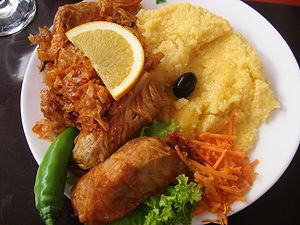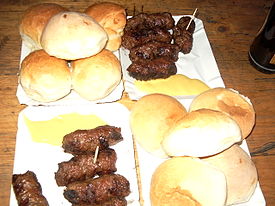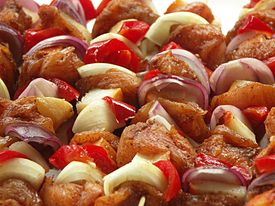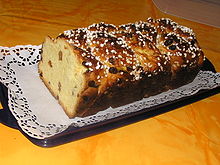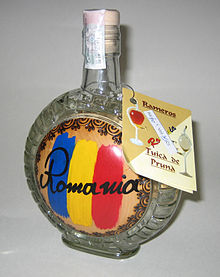- Romanian cuisine
-
Part of a series on the Culture of Romania 
Topics Literature Philosophy Music Art Theatre Cinema Architecture Cuisine Folklore Dress Professions Actors Composers Painters Poets Sculptors Writers Monuments Sites Castles Museums Religious UNESCO WHS Other Romanian language Famous Romanians Media Institute Sport Religion Humor
Romania Portal
Romanian cuisine is a diverse blend of different dishes from several traditions with which it has come into contact, but it also maintains its own character. It has been greatly influenced by Ottoman cuisine while it also includes influences from the cuisines of other neighbours, such as Germans, Serbians, and Hungarians.
Quite different types of dishes are sometimes included under a generic term; for example, the category ciorbă includes a wide range of soups with a characteristic sour taste. These may be meat and vegetable soups, tripe and calf foot soups (shkembe chorba or iskembe), or fish soups, all of which are soured by lemon juice, sauerkraut juice, vinegar, or traditionally borş (fermented wheat bran). The category ţuică (plum brandy) is a generic name for a strong alcoholic spirit in Romania, while in other countries, every flavour has a different name.
Contents
History
In history of romanian culinary literature, Costache Negruzzi and Mihail Kogălniceanu are the compilers of a cookbook ″200 reţete cercate de bucate, prăjituri şi alte trebi gospodăreşti″(200 tried recipies, cookies and other household things) printed in 1841[1]. Also, Negruzzi write in "Alexandru Lăpuşnenu": "In Moldavia at this time, fine food wasn't fashioned. Greater feast could have included few courses. After polish borş, greek dishes follow, boiled with herbs floating in butter, after that, turkish pilaf and finally cosmopolitan steaks"[2]
Description
A plate of sărmăluţe cu mămăligă, a popular Romanian dish of stuffed cabbage rolls (sarmale) accompanied by sauerkraut and mamaliga. The cabbage rolls are usually garnished with sour cream, not lemon and olive.
Romanian recipes bear the same influences as the rest of Romanian culture. The Turks have brought meatballs (perişoare in a meatball soup), from the Greeks there is musaca, from the Austrians there is the şniţel and the list could continue. The Romanians share many foods with the Balkan area (in which Turkey was the cultural vehicle), with Central Europe (mostly in the form of German-Austrian dishes introduced through Hungary or by the Saxons in Transylvania) and, finally, Eastern Europe. Some others are original or can be traced to the Roman or other ancient civilizations. The lack of written sources in Eastern Europe makes impossible to determine today the punctual origin for most of them.
One of the most common dishes is mămăliga, a cornmeal mush served on its own or as an accompaniment. Pork is the preferred meat, but beef, lamb, and fish are also popular.
Before Christmas, on December 20 (Ignat's Day or Ignatul in Romanian),[3] a pig is traditionally slaughtered by every rural family.[4] A variety of foods for Christmas prepared from the slaughtered pig consist of the following:
- cârnaţi/cărnaţi — spicy sausages
- caltaboşi/cartaboşi — sausages made with liver
- offal
- tobă and piftie — dishes using pig's feet, head and ears suspended in aspic
- tocătură/tochitură — pan-fried pork served with mămăligă and wine ("so that the pork can swim").
The Christmas meal is sweetened with the traditional cozonac (sweet bread with nuts) or rahat (Turkish delight) for dessert.
At Easter, lamb is served: the main dishes are roast lamb and drob de miel – a Romanian lamb haggis made of minced organs (heart, liver, lungs) wrapped and roasted in a caul.[5][6] The traditional Easter cake is pască, a pie made of yeast dough with a sweet cottage cheese filling at the center.[7][8]
Romanian pancakes, called clătită, are thin (like French crêpes) and can be prepared with savory or sweet fillings: ground meat, white cheese, or jam. Different recipes are prepared depending on the season or the occasion.[9]
Wine is the preferred drink, and Romanian wines have a tradition of over three millennia.[9] Romania is currently the world's 9th largest wine producer, and recently the export market has started to grow.[9] Romania produces a wide selection of domestic varieties (Fetească, Grasă, Tamâioasă , Busuioacă), as well as varieties from across the world (Italian Riesling, Merlot, Sauvignon blanc, Cabernet Sauvignon, Chardonnay, Muscat Ottonel). Beer is also highly regarded, generally blonde pilsener beer, made with German influences. There are also Romanian breweries with a long tradition.
According to the 2009 data of FAOSTAT, Romania is the world's second largest plum producer (after the United States)[10] and as much as 75% of Romania's plum production is processed into the famous palinca/ţuică, a plum brandy obtained through one or more distillation steps.[11]
List of dishes
Soups
- ciorbă (soup with characteristic sour taste)
- ciorbă de burtă (tripe soup)
- ciorbă de perişoare (meatball soup)
- ciorbă ţărănească de văcuţă (peasant beef soup)
- ciorbă de fasole cu afumătură (bean and smoked meat soup)
- ciorbă de peşte "ca-n Deltă" (fish soup prepared in the style of the Danube Delta)
- ciorbă de salată cu afumătură (green salad and smoked meat soup)
- ciorbă de legume (vegetables soup)
- supă (generic name for sweet (sometimes clear) soups, some times sweet variants of ciorbă)
Meat
- caltaboş/chişcǎ - a cooked sausage made of minced pork organs and rice, stuffed in a pig casing
- cârnaţi - a garlicky sausage, as in Fasole cu cârnaţi
- chiftele - a type of large meatball covered with a flour crust or breadcrumb crust
- ciulama - white roux sauce used in a variety of meat dishes
- ciulama de viţel - veal ciulama
- ciulama de pui - chicken ciulama
- drob de miel - a lamb haggis made of minced organs wrapped in a caul and roasted like a meatloaf; a traditional Easter dish
- frigărui - skewered meat
- limbă cu măsline - cow tongue with olives
- mititei (mici) - grilled minced-meat rolls
- musaca - an eggplant/potato and meat pie
- ostropel - method of cooking chicken or duck
- papricaş - Goulash
- pârjoale - burger
- piftie - meat jelly
- Pleşcoi sausages
- rasol - boiled meat with garlic or horseradish
- slănină (şuncă) - pork fat, often smoked
- şniţel - a breaded pork, veal, or beef cutlet (a variety of Viennese schnitzel)
- Cordon bleu şniţel - breaded pork tenderloin stuffed with cheese and ham
- mosaic şniţel - a specialty of Western Romania, two thin layers of different meats with mushroom or other vegetable filling
- şniţel de pui - breaded chicken breast cutlet
- stufat de miel - lamb, onion and garlic stew
- tobă - sausage (usually pig's stomach, stuffed with pork jelly, liver, and skin)
- tocană/tocaniţă - stew
- tocăniţă vânătorească - venison stew
- tochitură moldovenească - Moldavian stew
- tochitură ardelenească - Transylvanian stew
- varză călită - steamed cabbage with pork ribs, duck or sausages
- sarmale - minced meat with rice, wrapped in pickled cabbage leaves
Fish
- salata de icre - roe salad
- plachie din peşte - ragout of river fish with vegetables
- saramură de crap - carp in brine
- chiftele de peşte - fish cakes
- papricaş de peşte - fish paprikash
- crap pane - breaded carp fillets
- ghiveci cu peşte - vegetable stew with fish
- macrou afumat - smoked mackerel fillet
Vegetables
- ardei umpluţi - stuffed bell peppers
- dovlecei umpluţi - stuffed zucchini
- gulii umplute - stuffed kohlrabi
- vinete umplute - stuffed eggplant
- sarmale - stuffed cabbage rolls, also made with grape, dock leaves or many other leaves
- ghiveci - vegetable stew or cooked vegetable salad similar to the Bulgarian gjuvec and the Hungarian lecso[12][13]
- ghiveci cǎlugaresc - vegetable stew prepared by the nuns in the monasteries)
- tocana de ciuperci - mushroom stew
- iahnie - beans, spiced up, cooked until there's no more water and a soft sticky sauce binding beans together has formed
- mâncare de mazăre - pea stew
- mâncare de praz - leek stew
- pilaf - rice, vegetables and pieces of meat, often wings and organs of chicken
- mămăligă - cornmeal mush, polenta
- chifteluţe de ciuperci - chiftele made of mushrooms instead of meat
- şniţel de ciuperci - mushroom fritters - şniţel is the Romanian spelling of the German word schnitzel (breaded boneless cutlet) but it may be used to mean any sort of fritter
- zacuscă - vegetable spread, made by cooking a mix of many different vegetables (eggplant—roasted and peeled, peppers—sometimes roasted and peeled, onions, tomatoes, carrots, parsley roots) with oil until they become a paste
Pies
- plăcinte (pies)
List of salads
- borş - fermented wheat bran, a souring agent for ciorbă
- ardei copţi - roasted peppers
- murături - pickled vegetables (most often in brine but also using vinegar)
- castraveţi muraţi - pickled cucumbers
- gogonele - pickled unripe tomatoes
- varză murată - pickled cabbage
- murături asortate - pickled mixed vegetables - onions, garlic, unripe tomatoes, peppers, cucumbers, kohlrabi, beet, carrots, celery, parsley roots, cauliflower, apples, quinces, unripe plums, small unripe watermelons, small zucchini, red cabbage
- mujdei - crushed garlic sauce
- salată de boeuf - minced boiled vegetables with meat mayo and a dash of mustard
- salată de vinete - roasted and peeled eggplants, chooped onion, salt, mixed with mayo
- salată orientala - potato salad with eggs, onions, olives
- salată de sfeclă - beet salad
- salată de roşii cu ceapa - tomato and onions salad
List of cheese types
The generic name for cheese in Romania is brânză and it is considered to be of Dacian origin. Most of the cheeses are made of cow's or sheep's milk, goat's milk is rarely used. Sheep cheese is considered "the real cheese", although in modern times some people refrain from consuming it due to its higher fat content and specific smell.
- brânză de burduf - sheep's milk, kneaded cheese with a strong taste and semi-soft texture, stuffed into a pig's bladder, traditional product
- brânză de vaci - cottage cheese
- brânză topită - melted cheese; a generic name for processed cheese, industrial product only
- brânză de coşuleţ - same cheese as brânză de burduf, but stuffed into bellows of fir tree bark instead of pig bladder, very lightly smoked, traditional product
- caşcaval - semi-hard cheese made with sheep's or cow's milk, traditional product
- caş - semi-soft fresh white cheese, unsalted, sometimes lightly salted, stored in brine, which is eaten fresh (cannot be preserved), softer than feta cheese, a base for telemea, traditional, seasonal product
- telemea - semi-soft white cheese (brinza) with a creamy texture and a tangy taste, matured in brine, somewhat similar to feta cheese, traditional product
- urdă - made by boiling the whey drained from cow's or ewe's milk until the remaining proteins precipitate and can be collected; almost fat-free, bland in taste; most often mixed with cream or butter and herbs or spices to prepare tasty spreads, traditional product[citation needed]
List of desserts
- Baklava - phyllo pastry filled with nuts and sweetened with honey/sugar syrup
- Covrigi - pretzels[14]
- Gogoşi - doughnuts[15]
- Halva
- Rahat - Turkish delight
- Plăcintă - pie
- Colivă - boiled wheat, mixed with sugar and walnuts (often decorated with candy and icing sugar; distributed at funerals and/or memorial ceremonies
- Cozonac - a kind of Stollen made with leavened dough, into which milk, eggs, sugar, butter, and other ingredients are mixed
- Pandişpan - sponge cake
- Orez cu lapte - rice pudding
- Griş cu lapte - cream of wheat, semolina with milk
- Lapte de pasăre - literally "bird's milk", vanilla custard garnished with "floating islands" of whipped egg whites
- Cremă de zahăr ars - crème caramel/crème brûlée
- Clătite - crêpe
- Turtă dulce - gingerbread
- Chec - a sort of coffee cake
- Papanaşi - a kind of doughnut made from a mixture of sweet cheese, eggs, and semolina, boiled or fried and served with fruit syrup or jam and sour cream
- Şarlotă - a custard made with milk, eggs, sugar, whipped cream, gelatin, fruits, and lady fingers; from the French charlotte
- Prăjituri - assorted pastries:
-
- Savarine - savarina[16])
- Amandine - chocolate sponge cake filled with almond cream
- Joffre cake - invented at the Casa Capşa restaurant in Bucharest
- Mucenici - sweet cookies (shaped like "8", made of boiled or baked dough, garnished with walnuts, sugar or honey, eaten on a single day of the year, on 9 March)[17]
List of drinks
- socată - Elderflower Champagne
- bere - beer
- ţuică - plum brandy
- horincă - plum brandy, produced near the border with Ukraine
- şliboviţă - similar to horilcă, produced near the border with Serbia
- rachiu - fruit brandy
- secărică - caraway seed brandy
- turţ - strong plum brandy (named after the village of Turţ in northwestern Romania)
- afinată - blueberry liqueur
- zmeurată - raspberry liqueur
- vişinată - sour cherry liqueur
- vin - wine
- vodcă - vodka
Personalities
- Radu Anton Roman - author of Romanian cookbooks
- Sanda Marin - author of a famous Romanian cookbook
- Alexandru O. “Păstorel” Teodoreanu - Romanian writer between the two World Wars, connoisseur of wines and food
Notes and references
- ^ http://www.bucatarescu.ro/2010/05/bogdan-ulmu-retete-de-la-kogalniceanu-negruzzi/
- ^ ″Lumea″ nr 17,1946,p 1,Art:O carte de bucate, G. Călinescu
- ^ Ignatul or Ignat's Day (December 20)
- ^ Christmas customs in Romania: "pig's ritual sacrifice"
- ^ Making lamb drob
- ^ Traditional recipe for drob de miel, with step-by-step photos
- ^ A photo of pasca
- ^ Pasca recipe
- ^ a b c Educations.com/Study in Romania
- ^ "Final 2009 Data". Food and Agriculture Organization of the United Nations. http://faostat.fao.org/site/567/DesktopDefault.aspx?PageID=567#ancor.
- ^ Ţuica production consumed 75% of Romanian plums in 2003
- ^ Ghiveci: Romanian vegetable stew
- ^ Recipe for ghiveci
- ^ Covrigi on display
- ^ Varieties of gogoşi: photos and recipes (Romanian)
- ^ Recipe for savarina
- ^ Mucenici: background and recipe
Other sources
- Nicolae Klepper, Taste of Romania, Hippocrene, New York, 1999, ISBN 978-0-7818-0766-1, ISBN 0-7818-0766-2
External links
- List of dishes served in a Romanian restaurant (Romanian)
- Romanian Cuisine
- Romanian Recipes Cuisine
- A Romanian recipes website
- Romanian recipe wiki
European cuisine Sovereign
states- Albania
- Andorra
- Armenia
- Austria
- Azerbaijan
- Belarus
- Belgium
- Bosnia and Herzegovina
- Bulgaria
- Croatia
- Cyprus
- Czech Republic
- Denmark
- Estonia
- Finland
- France
- Georgia
- Germany
- Greece
- Hungary
- Iceland
- Ireland
- Italy
- Kazakhstan
- Latvia
- Liechtenstein
- Lithuania
- Luxembourg
- Macedonia
- Malta
- Moldova
- Monaco
- Montenegro
- Netherlands
- Norway
- Poland
- Portugal
- Romania
- Russia
- San Marino
- Serbia
- Slovakia
- Slovenia
- Spain
- Sweden
- Switzerland
- Turkey
- Ukraine
- United Kingdom
- (England
- Northern Ireland
- Scotland
- Wales)
- Vatican City
States with limited
recognition- Abkhazia
- Kosovo
- Nagorno-Karabakh Republic
- Northern Cyprus
- South Ossetia
- Transnistria
Dependencies
and other territories- Åland
- Faroe Islands
- Gibraltar
- Guernsey
- Jan Mayen
- Jersey
- Isle of Man
- Svalbard
 Romania topics
Romania topicsBasic topics · Alphabetical index of topics History Timeline · Prehistoric Romania · Dacia · Roman Dacia · Middle Ages · Early Modern Era · National awakening · United Principalities · Kingdom of Romania · World War I · Greater Romania · World War II · Communist Romania · 1989 Romanian Revolution · Since 1989Geography Economy Government Constitution · Parliament (Senate · Chamber of Deputies) · President · Prime Minister · Elections · Political parties · Foreign relations · Government Agencies · Law enforcement · History · Land Forces · Air Force · Naval Forces · Military Police · Administrative divisions · Counties · Cities · Human rights ·Culture Orthodox Christianity · Holy Synod · Judaism · Islam · Postal codes · Languages · Religion · Minorities · Immigration · Romanians · List of Romanians · Academy · Architecture · Art · Cinema (Actors) · Music (Composers) · Cuisine · Romanian language · Literature (Writers • Poets) · List of Romanians · Philosophy · Folklore (Dress) · Humour · Media · Sport · Public holidays · Society · CrimeWikiProject • Portal • Commons Categories:
Wikimedia Foundation. 2010.

